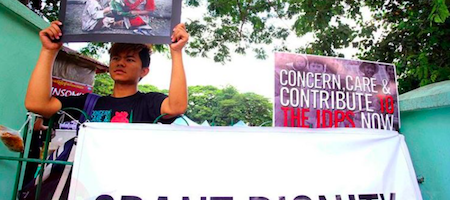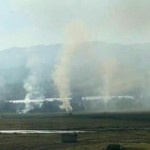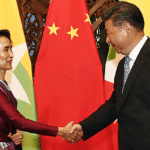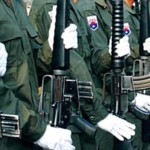By Stella Naw / The Irrawaddy | December 20, 2016
The Burma Army attack on the Kachin Independence Army (KIA) outpost of Gideon started in September.
Four months later, after intensified fire from the air and ground, Gideon fell in December.
The final push to seize the location was perhaps important for the Tatmadaw’s own pride: according to one ex-army officer—who spoke on the condition of anonymity—to conquer the outpost would serve as proof that the Tatmadaw could still deliver military “results.” On Jan. 4, the day on which Burma celebrates its 1948 independence from the British Empire, the officer predicts that Tatmadaw members will be honored for their “bravery” demonstrated in Gideon.
Many ethnic Kachin are convinced that the Burma Army’s timing in launching a full assault on the location—and then seizing it—was not a coincidence, but a strategic campaign to terrorize the Christian minority during the holiest month of the year. It is not the first time that the Kachin community has experienced this kind of violence so near to Christmas: in December 2012, the Burma Army employed indiscriminate air strikes involving heavy artillery near Laiza, the KIA’s headquarters, according to reports from local aid organizations on the ground.
The loss of Gideon is not only physical, but symbolic, explained one religious leader.
“There is this phenomenon called a ‘Christmas truce’ where two warring parties temporarily and unofficially halt their fire. But for the Burmese army, it is their way of insulting and undermining our Christian faith,” said Rev. Hkalam Samson of the Kachin Baptist Convention (KBC).
A social media post by the Burma Army’s Ohn Myint declared that the ex-general was “feeling proud” in light of the government forces’ actions in Gideon and that he possessed “much respect for the history of the Tatmadaw.”
Yet what is missing from calculations surrounding the Tatmadaw’s campaign against Gideon is the impact of the lost lives, the battle injuries and the financial cost of the conflict. Not least also, is the continued displacement of an already-uprooted civilian population now pushed further to the brink.
The ex-officer from the Burma Army estimated the death toll of the Tatmadaw as 400 to 500 Burmese soldiers in the fight for Gideon alone; the same source suggested 20-30 KIA casualties, citing a KIA advantage due to their defensive positioning and familiarity with the terrain.
Seizing Gideon likely cost the Burmese military millions of dollars. A regional security analyst with British security and defense publisher IHS Jane’s Information Group estimated the cost of a 227-kg air-dropped bomb to be around US$2,000, not including aircraft fuel and maintenance costs. A case of 120-mm rounds of mortar shells cost $4,000 per case.
As of mid-December, there had been more than 2,000 rounds of shelling, according to sources on the ground.
Burma, relegated to the status of a Least Developed Country by the UN for nearly 30 years, cannot afford such warfare. Yet during the recent Union Parliament session in December, the Ministry of Defense was the only ministry whose proposal for additional funding was approved; others saw their budgets reduced for the next fiscal year.
On who bears the actual cost of war, one resident of Myitkyina, Kachin State, said, “The Burma Army is killing us with our own tax money. I pay taxes to have my relatives shot.”
Displacement and Food Cuts
In Mung Lai Hkyet, a makeshift internally displaced people’s (IDP) camp outside of Gideon, a local relief worker from Laiza reported that shelling by the Burma Army continued even after the fall of the KIA outpost.
“Due to bombardment by government troops since 4:30 a.m., the IDPs are fleeing again,” he said on Dec. 18. There were more than 600 people in the camp, mostly elderly people and children.
Government restrictions on aid and cuts to humanitarian assistance by international donors have justify this population largely forgotten and unable to meet their basic needs for survival.
Little has been reported on the humanitarian crisis facing those displaced due to recent conflict in northern Burma, as few people have access to these populations. The closest I was able to get to the conflict zone was Manghai, across the Chinese border from Mong Ko in northern Shan State. Mong Ko saw heavy fighting between the ethnic Kokang Myanmar National Democratic Alliance Army (MNDAA) and the Burma Army before ethnic forces withdrew in early December. The MNDAA is also one of the main forces behind the ethnic armed coalition known as the Northern Alliance, of which the KIA, the Ta’ang National Liberation Army and the Arakan Army are also members.
It was in Manghai that I met Ah Ra, a shaking 13-year-old girl. She explained that her mother and two of her younger siblings were seriously injured by splinters from Burma Army mortar shells fired in the area.
Those who have dared to return to villages in the Mong Ko area have reported encountering intimidation and threats from the government forces who now control the region. While Chinese authorities initially registered IDPs who fled across the border in order to provide them with aid, those who opted to return to Shan State had their names removed from such lists. If they flee to China for a second time, they say they are being told they are no longer eligible for basic rations.
An Attack on One Kachin, An Attack on All
The Kachin are connected through a strong and close-knit clan-based kinship system. It can be said that the breakdown of the 17-year ceasefire between the Burma Army and the KIA in 2011 has once again united them, in both grief and resilience.
A concept which has become a symbol of the resistance over the last five years is that of “rau,” which translates to “together” in the Kachin (Jinghpaw) language. The resurgence of a strong cultural and political identity, particularly within the younger generation, is a relatively new phenomenon—and a direct result of intensified Burma Army violence and repression.
Respect and legitimacy cannot be achieved through continued destruction and traumatization of Burma’s ethnic communities. With each attack, grievances grow, pushing groups like the Kachin to further resist subjugation by the Tatmadaw and the central government.
The only way to repair the broken trust between the country’s marginalized ethnic nationalities and the Burmese government is for a complete halt to attacks by the armed forces in the ethnic states.
Burma’s peace process and path toward a genuine federal Union is entering perhaps its darkest period yet. Members of the international community should refrain from pressuring ethnic armed organizations to sign the country’s divisive nationwide ceasefire agreement, and instead encourage alternative solutions and steps in partnership with the non-signatory groups.
Reducing or eliminating humanitarian aid to IDPs during times of war is arguably an act of bullying. These vulnerable populations have virtually no say in the peace process, despite being severely affected by the conflict it seeks to address. Although well intentioned, “durable solution models” that claim to foster self-reliance among IDPs must not become the primary justification for cutting funds to these communities. Instead, their will to live with dignity must be supported through the establishment of systems and networks designed to deliver the assistance they need to survive. In the meantime, they will continue to await the guarantees of peace and security needed in order to return home.
This article originally appeared on the Irrawaddy on December 20, 2016.







